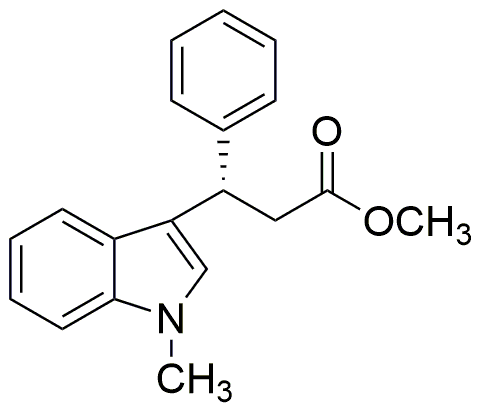Methyl (3S)-(+)-3-(methyl-1H-indol-3-yl)-3-phenylpropionate is widely utilized in research focused on:
- Pharmaceutical Development: This compound serves as a valuable intermediate in the synthesis of various pharmaceuticals, particularly in developing drugs targeting neurological disorders due to its indole structure, which is known for its biological activity.
- Agricultural Chemistry: It is used in formulating agrochemicals, enhancing crop protection products. Its unique properties can improve the efficacy of pesticides and herbicides, making them more effective against pests while being less harmful to beneficial organisms.
- Flavor and Fragrance Industry: The compound is employed in creating flavoring agents and fragrances. Its pleasant aromatic profile makes it suitable for use in perfumes and food flavorings, providing a natural scent and taste enhancement.
- Material Science: In polymer chemistry, it can be used as a building block for creating novel materials with specific properties, such as improved thermal stability and mechanical strength, beneficial for various industrial applications.
- Biochemical Research: Researchers utilize this compound to study its interactions with biological systems, aiding in understanding metabolic pathways and potential therapeutic targets, which can lead to innovative treatments.
General Information
Properties
Safety and Regulations
Applications
Methyl (3S)-(+)-3-(methyl-1H-indol-3-yl)-3-phenylpropionate is widely utilized in research focused on:
- Pharmaceutical Development: This compound serves as a valuable intermediate in the synthesis of various pharmaceuticals, particularly in developing drugs targeting neurological disorders due to its indole structure, which is known for its biological activity.
- Agricultural Chemistry: It is used in formulating agrochemicals, enhancing crop protection products. Its unique properties can improve the efficacy of pesticides and herbicides, making them more effective against pests while being less harmful to beneficial organisms.
- Flavor and Fragrance Industry: The compound is employed in creating flavoring agents and fragrances. Its pleasant aromatic profile makes it suitable for use in perfumes and food flavorings, providing a natural scent and taste enhancement.
- Material Science: In polymer chemistry, it can be used as a building block for creating novel materials with specific properties, such as improved thermal stability and mechanical strength, beneficial for various industrial applications.
- Biochemical Research: Researchers utilize this compound to study its interactions with biological systems, aiding in understanding metabolic pathways and potential therapeutic targets, which can lead to innovative treatments.
Documents
Safety Data Sheets (SDS)
The SDS provides comprehensive safety information on handling, storage, and disposal of the product.
Product Specification (PS)
The PS provides a comprehensive breakdown of the product’s properties, including chemical composition, physical state, purity, and storage requirements. It also details acceptable quality ranges and the product's intended applications.
Certificates of Analysis (COA)
Search for Certificates of Analysis (COA) by entering the products Lot Number. Lot and Batch Numbers can be found on a product’s label following the words ‘Lot’ or ‘Batch’.
*Catalog Number
*Lot Number
Certificates Of Origin (COO)
This COO confirms the country where the product was manufactured, and also details the materials and components used in it and whether it is derived from natural, synthetic, or other specific sources. This certificate may be required for customs, trade, and regulatory compliance.
*Catalog Number
*Lot Number
Safety Data Sheets (SDS)
The SDS provides comprehensive safety information on handling, storage, and disposal of the product.
DownloadProduct Specification (PS)
The PS provides a comprehensive breakdown of the product’s properties, including chemical composition, physical state, purity, and storage requirements. It also details acceptable quality ranges and the product's intended applications.
DownloadCertificates of Analysis (COA)
Search for Certificates of Analysis (COA) by entering the products Lot Number. Lot and Batch Numbers can be found on a product’s label following the words ‘Lot’ or ‘Batch’.
*Catalog Number
*Lot Number
Certificates Of Origin (COO)
This COO confirms the country where the product was manufactured, and also details the materials and components used in it and whether it is derived from natural, synthetic, or other specific sources. This certificate may be required for customs, trade, and regulatory compliance.


